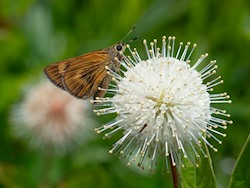Byssus Skipper Problema byssus
Butterfly: Wingspan: 1½ to 1¾ inches (3.6 - 4.6 cm). UPPER SURFACE (dorsal) Bright yellow orange ground color; wide dark borders. Male forewing has a small black V-shaped bar. Female forewing has wider borders; orange forms a semicircle of spots. UNDER SURFACE (ventral) Wings range from orange to yellow brown. Forewing has yellow spot band and short black vertical bar. Hindwing has yellow spot band and yellow veins. Wing fringe white/buffy. Antennal clubs almost all black.
Egg: A somewhat flattened hemisphere. White when laid, turning pinkish.
Caterpillar: Bluish green; covered with fine white hairs. Head white, narrowly edged with black; three black vertical stripes cross facial area. Young caterpillars have a black patch on posterior. Later instars have yellow wash on thorax and posterior. Heart line dark. Collar white at top, dark at back. First two pairs of legs (thoracic) darker than other two. Partially grown caterpillars overwinter.
Chrysalis: Initially shades of tan, eventually turning dark brown.












_Charny.jpg)
_Charny.jpg)
_Charny-copy.jpg)


_Charny.jpg)






_Charny.jpg)
_Charny.jpg)
_Charny.jpg)


_Charny.jpg)
_Charny.jpg)























_Charny.jpg)